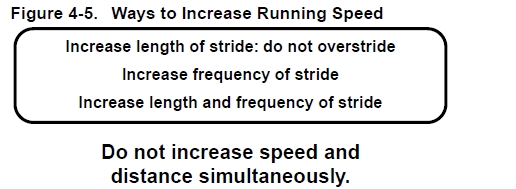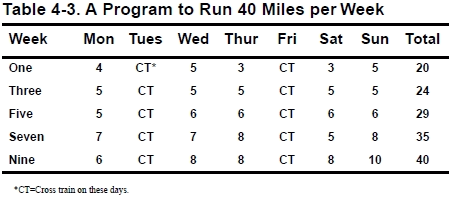Increasing mileage too quickly can cause training injuries. Your running mileage
should be gradually increased and not by more than 10% to 20% from one week to the next.
For example, if you can comfortably run four miles, increase your distance by a mile and
maintain this new mileage for at least one to two weeks or until this distance is consistently
easy for you. Also, remember consistency is more important than speed.
A good rule of thumb: increase your
mileage by no more than 20% a week.
When you can continuously run for 40 minutes, begin thinking about your running
mileage or distance. Most of you, unless coming back from an injury or returning from a
deployment, are already running 30 to 40 minutes as part of your fitness routine. However,
if you have been unable to run for some time due to reasons mentioned above or other
reasons, start out slowly; this will prevent you from getting injured and benefit you in the
long run.
Running Frequency
Run at least three to four times per week or every other day. It is a good idea to buildin one or two rest days in your weekly running schedule. These rest days do not necessarily
mean no exercise, but rather an alternate type of exercise, such as biking or swimming. This
allows your “running muscles” time for rest and recovery, and helps prevent overuse
training injuries.
Running Speed and Intensity
When running for exercise and not competition, you should run at an even pace thatallows you to talk comfortably. If you run too fast and get breathless, you may not be able
to go the distance. Also, speed work tends to tighten muscles and must be properly
stretched afterwards. Failure to stretch may lead to an injury. One way to estimate your
training intensity is to check your heart rate and see if it falls within your target training
zone As previously mentioned, speed is not as important as being able to
go the distance consistently. Figure 4-5 presents tips on how to increase your running
speed.
Increasing both at the same time may cause an injury. Hold one constant while you
gradually increase the other. After you have been running 30 minutes continuously 3 - 5
times per week, you can begin increasing your running distance. Running 20 to 30 miles
per week is a good training distance for an intermediate runner. If you would like to further
increase your weekly mileage, remember to increase it by no more than 20% per week.
Table 4-3 provides a nine week program for running up to 40 miles per week.
The program in Table 4-3 provides a basic template for you. Based on your own
routine, you could modify this program to fit your schedule and requirements. Another way
to vary your workout is to have one long slow run and one fast run per week. Remember if
you feel over tired, cut back your mileage or take a day off from running. With a running
base of 40 miles per week you can easily run a half marathon.



